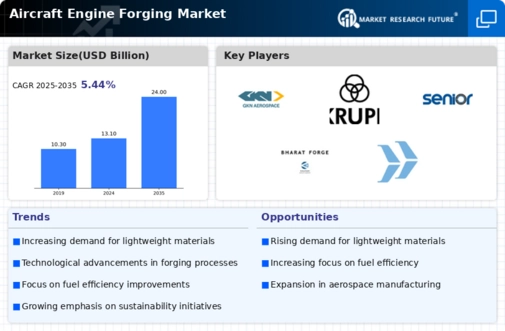Market Trends and Projections
Growth of the Aerospace Sector
The Global Aircraft Engine Forging Market Industry is closely tied to the growth of the aerospace sector, which continues to expand due to rising air travel demand. With the global passenger traffic expected to double by 2035, airlines are investing heavily in new aircraft and engine technologies. This trend drives the need for high-quality forged components that can withstand the rigors of modern aviation. The market is anticipated to reach 24.0 USD Billion by 2035, underscoring the importance of robust supply chains and manufacturing capabilities in meeting future demands. As a result, the forging industry must adapt to support this growth effectively.
Emerging Markets and Globalization
Emerging markets and globalization are reshaping the Global Aircraft Engine Forging Market Industry. Countries such as India and China are witnessing rapid growth in their aviation sectors, driven by rising disposable incomes and urbanization. This expansion creates opportunities for local manufacturers to engage in aircraft engine forging, thereby enhancing global supply chains. Additionally, globalization facilitates collaboration between established aerospace firms and emerging players, fostering innovation and competitiveness. As these markets develop, the demand for forged components is expected to rise, further propelling the industry forward.
Increased Investment in Defense Aviation
Increased investment in defense aviation is a key driver of the Global Aircraft Engine Forging Market Industry. Governments worldwide are allocating substantial budgets to enhance their military capabilities, leading to a surge in demand for advanced aircraft engines. This trend is particularly evident in regions with heightened geopolitical tensions, where nations prioritize the modernization of their air fleets. The defense sector's focus on high-performance engines necessitates the use of superior forged materials, thereby bolstering the market. As defense budgets continue to rise, the forging industry is likely to benefit from increased orders and contracts.
Rising Demand for Fuel-Efficient Engines
The Global Aircraft Engine Forging Market Industry is experiencing a notable surge in demand for fuel-efficient engines. As airlines and manufacturers increasingly prioritize sustainability, the need for advanced engine technologies that reduce fuel consumption becomes paramount. This shift is driven by regulatory pressures and consumer preferences for environmentally friendly travel options. Consequently, the market is projected to reach 13.1 USD Billion in 2024, reflecting a growing emphasis on innovation in engine design and materials. The adoption of lightweight forged components plays a crucial role in enhancing fuel efficiency, thereby propelling the market forward.
Technological Advancements in Forging Processes
Technological advancements in forging processes are significantly influencing the Global Aircraft Engine Forging Market Industry. Innovations such as precision forging and additive manufacturing are enhancing the quality and performance of forged components. These advancements enable manufacturers to produce complex geometries with improved mechanical properties, which are essential for modern aircraft engines. As a result, the industry is likely to witness a compound annual growth rate of 5.67% from 2025 to 2035. The integration of smart manufacturing techniques further optimizes production efficiency, thereby meeting the increasing demands of the aerospace sector.
















